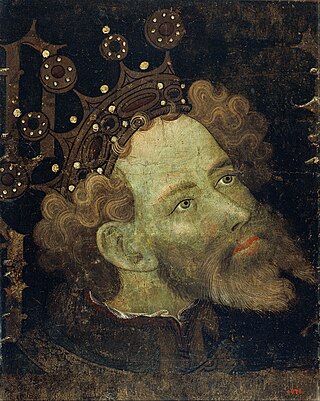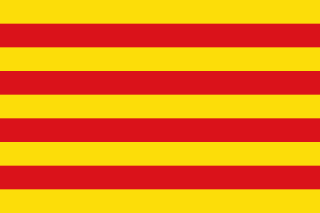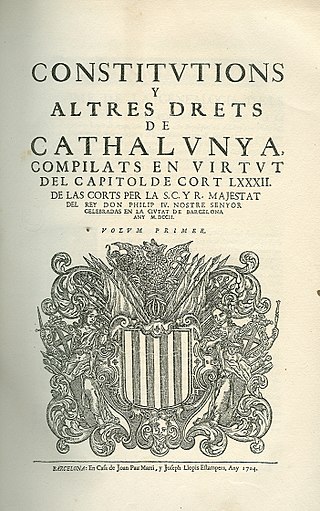
Catalonia is an autonomous community of Spain, designated as a nationality by its Statute of Autonomy. Most of its territory lies on the northeast of the Iberian Peninsula, to the south of the Pyrenees mountain range. Catalonia is administratively divided into four provinces or eight regions, which are in turn divided into 42 comarques. The capital and largest city, Barcelona, is the second-most populated municipality in Spain and the fifth-most populous urban area in the European Union.
Generalitat is the name of two major medieval and early modern political institutions and their modern-day analogues in Kingdom of Spain. The ancient Principality of Catalonia and the Kingdom of Valencia were ruled by Generalitats. Today, Catalonia and The Valencian Community have systems of self-government called Generalitats, and are two of 17 autonomous communities of Spain. The term is also used for the government of the semi-autonomous comarca of Val d'Aran, the Generalitat a l'Aran.

The lands of what today is known as Catalonia, in Spain, were first settled during the Middle Palaeolithic era. Like the rest of the Mediterranean side of the Iberian Peninsula, the area was occupied by the Iberians and several Greek colonies were established on the coast before the Roman conquest. It was the first area of Hispania conquered by the Romans. It then came under Visigothic rule after the collapse of the western part of the Roman Empire. In 718, the area was occupied by the Umayyad Caliphate and became a part of Muslim ruled al-Andalus. The Frankish Empire conquered the area from the Muslims, ending with the conquest of Barcelona in 801, as part of the creation of a larger buffer zone of Christian counties against Islamic rule historiographically known as the Marca Hispanica. In the 10th century the County of Barcelona became progressively independent from Frankish rule.

Peter IV, called the Ceremonious, was from 1336 until his death the king of Aragon, Sardinia-Corsica, and Valencia, and count of Barcelona. In 1344, he deposed James III of Majorca and made himself King of Majorca.
The Generalitat de Catalunya, or the Government of Catalonia, is the institutional system by which Catalonia politically organizes its self-government as an autonomous community of Spain. It is formed by the Parliament of Catalonia, the Presidency of the Generalitat de Catalunya, and the Executive Council of Catalonia. It is ruled according to the Statute of Autonomy of Catalonia.

Pau Claris i Casademunt was a Catalan lawyer, clergyman and 94th President of the Deputation of the General of Catalonia at the beginning of the Catalan Revolt. On 16 January 1641 he proclaimed the Catalan Republic under the protection of France.

The Kingdom of Aragon was a medieval and early modern kingdom on the Iberian Peninsula, corresponding to the modern-day autonomous community of Aragon, in Spain. It should not be confused with the larger Crown of Aragon, which also included other territories—the Principality of Catalonia, the Kingdom of Valencia, the Kingdom of Majorca, and other possessions that are now part of France, Italy, and Greece—that were also under the rule of the King of Aragon, but were administered separately from the Kingdom of Aragon.

The Crown of Aragon was a composite monarchy ruled by one king, originated by the dynastic union of the Kingdom of Aragon and the County of Barcelona and ended as a consequence of the War of the Spanish Succession. At the height of its power in the 14th and 15th centuries, the Crown of Aragon was a thalassocracy controlling a large portion of present-day eastern Spain, parts of what is now southern France, and a Mediterranean empire which included the Balearic Islands, Sicily, Corsica, Sardinia, Malta, Southern Italy and parts of Greece.

The 1412 Compromise of Caspe was an act and resolution of parliamentary representatives of the constituent realms of the Crown of Aragon, meeting in Caspe, to resolve the interregnum following the death of King Martin of Aragon in 1410 without a legitimate heir.

The Parliament of Catalonia is the unicameral legislature of the autonomous community of Catalonia. The Parliament is currently made up of 135 members, known as deputies (diputats/deputats/diputados), who are elected for four-year terms or after extraordinary dissolution, chosen by universal suffrage in lists of four constituencies, corresponding to the Catalan provinces. The Parliament building is located in Ciutadella Park, Barcelona.

The Principality of Catalonia was a medieval and early modern state in the northeastern Iberian Peninsula. During most of its history it was in dynastic union with the Kingdom of Aragon, constituting together the Crown of Aragon. Between the 13th and the 18th centuries, it was bordered by the Kingdom of Aragon to the west, the Kingdom of Valencia to the south, the Kingdom of France and the feudal lordship of Andorra to the north and by the Mediterranean Sea to the east. The term Principality of Catalonia was official until the 1830s, when the Spanish government implemented the centralized provincial division, but remained in popular and informal contexts. Today, the term Principat (Principality) is used primarily to refer to the autonomous community of Catalonia in Spain, as distinct from the other Catalan Countries, and usually including the historical region of Roussillon in Southern France.

The Reapers' War, also known as the Catalan Revolt, was a conflict that affected the Principality of Catalonia between the years of 1640 and 1659. It had an enduring effect in the Treaty of the Pyrenees (1659), which ceded the County of Roussillon and the northern half of the County of Cerdanya to France, splitting these northern Catalan territories off from the Principality of Catalonia and the Crown of Aragon, and thereby receding the borders of Spain to the Pyrenees.

The Palau de la Generalitat de Catalunya is a historic palace in Barcelona, Catalonia, Spain. It houses the offices of the Presidency of the Generalitat de Catalunya. It is one of the few buildings of medieval origin in Europe that still functions as a seat of government and houses the institution that originally built it.

The Catalan constitutions were the laws of the Principality of Catalonia promulgated by the Count of Barcelona and approved by the Catalan Courts. The Corts in Catalan have the same origin as courts in English but instead meaning the legislature. The first constitutions were promulgated by the Corts of 1283. The last ones were promulgated by the Corts of 1705. They had pre-eminence over the other legal rules and could only be revoked by the Catalan Courts themselves. The compilations of the constitutions and other rights of Catalonia followed the Roman tradition of the Codex.

Catalonia is internally divided into eight regional divisions, known in Catalan as vegueries, following the regional plan of Catalonia. Each vegueria is further divided into comarques and municipalities, with the exception of the Aran Valley, considered a "unique territorial entity".
The Catalan Civil War, also called the Catalonian Civil War or the War against John II, was a civil war in the Principality of Catalonia, then part of the Crown of Aragon, between 1462 and 1472. The two factions, the royalists who supported John II of Aragon and the Catalan constitutionalists, disputed the extent of royal rights in Catalonia. The French entered the war at times on the side on John II and at times with the Catalans. The Catalans, who at first rallied around John's son Charles of Viana, set up several pretenders in opposition to John during the course of the conflict. Barcelona remained their stronghold to the end: with its surrender the war came to a close. John, victorious, re-established the status quo ante bellum.
Alfons de Tous was president of the Generalitat of Catalonia 1396-1413, succeeding Miquel de Santjoan when the latter left the Principality of Catalonia in 1396 to become a royal ambassador.

The Catalan Republic was a short-lived independent state under French protection proclaimed in 1641 by the Junta de Braços of the Principality of Catalonia led by the President of the Generalitat, Pau Claris, during the Reapers' War (1640-1652).
The Junta de Braços or Braços Generals (States-General) was, during the early modern age, an institution of the Principality of Catalonia, convened by the Generalitat of Catalonia in cases of emergency or urgency. It was composed by the representatives of the Catalan Courts who at that time were in Barcelona.
The War of the Catalans or Particular War of Catalonia was one of the last military campaigns of the War of the Spanish Succession, which affected the Principality of Catalonia. This last phase of the conflict began when, despite the armistice signed between Philip V and Charles VI of Austria that put an end to the war from July 1, 1713, the Three Commons of Catalonia—the most prominent Catalan political institutions: the Generalitat, the Military Arm of Catalonia and the Consell de Cent of Barcelona—unilateraly proclaimed on 9 July 1713 the continuation of the war against Philip V and France, thus prolonging the war until 12 September 1714.
















